Decline in academic ability and "education with yutori or flexibility"
It is pointed out that the implementation of "education with yutori or flexibility" may have been a mistake, which is thought is the cause for decline in academic ability. Education with yutori or flexibility was proposed about twenty years ago, and at that time it was referred to as "education with flexibility and fulfillment (see Figure 1)." However, nowadays it seems that the term "fulfillment" is forgotten and only the "flexibility" is highlighted.
Figure 1 Development of school education
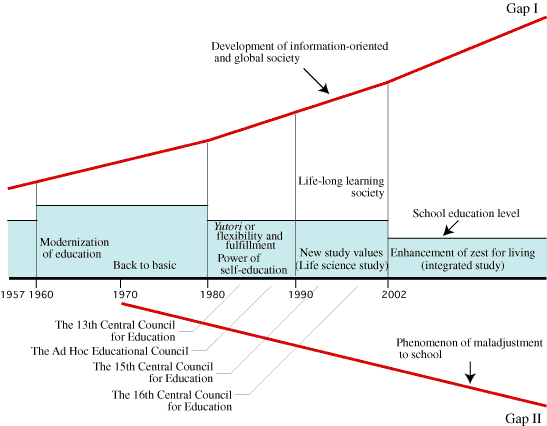 In fact, education with flexibility and fulfillment is related to the first spacecraft launch in 1957 by the former Soviet Union. Until then, the United States had been regarded as the leading country in various fields such as industry, science and economy. The U.S. was tremendously shocked, as is called the Sputnik Shock, worrying that the country might be defeated by the Soviet Union in the field of science. In order to overcome the Soviet Union, the United States improved the educational contents, particularly in physics and mathematics. Japan was also influenced by this tendency. Policies to improve educational contents in the name of "educational modernization" were introduced in the 1960s and continued during the next twenty years. However, as educational contents became more sophisticated, there were many students in the United States who could not follow them. Then the United States proposed a new policy to "go back to basics".
In fact, education with flexibility and fulfillment is related to the first spacecraft launch in 1957 by the former Soviet Union. Until then, the United States had been regarded as the leading country in various fields such as industry, science and economy. The U.S. was tremendously shocked, as is called the Sputnik Shock, worrying that the country might be defeated by the Soviet Union in the field of science. In order to overcome the Soviet Union, the United States improved the educational contents, particularly in physics and mathematics. Japan was also influenced by this tendency. Policies to improve educational contents in the name of "educational modernization" were introduced in the 1960s and continued during the next twenty years. However, as educational contents became more sophisticated, there were many students in the United States who could not follow them. Then the United States proposed a new policy to "go back to basics".In the late 1970s, a survey was conducted in Japan to see to what extent children understood their lessons. It turned out that only 70%, 50% and 30% of elementary, junior high and high school students, understood what was being taught. People at the educational settings called this result "7-5-3 education", feeling a serious sense of crisis. This is when people started to call for education in a worry-free and enriched environment.
At that time, educational reform was aimed to lower the educational level that had been too high while trying to mitigate competition for entrance exams and to avoid "examination hell," so that children could spend their time with yutori. Behind the call for such a worry-free environment, there were expectations that children will do what they were willing to do. "Time for yutori" was incorporated into the school curriculum. What happened in the next twenty years, however, was a drastic reduction in educational contents.
Educational system starting from 2002 is an extension of education with yutori. For example, about thirty years ago, students used to take 628 hours of science classes during six years of elementary school education. Starting from 2002, the number of hours will be reduced to 350, with 40% reduction (see Figure 2). Likewise in junior high schools, the number of hours is reduced from 420 to 290. With 40% reduction in the number of hours in science class, there is no doubt that the student's academic ability will be lowered.
Figure 2 Change in the number of hours for science classes at elementary and junior high schools
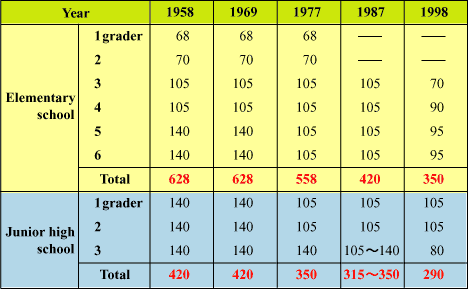 Reduction in educational contents not only lowers academic ability, but also influences children's way of learning. For example, there is an increasing number of children who do not study as they used to. A survey conducted in 1999 reports that more than 40% of Japanese high school students do not study out of school. Even those who study study only about an hour (see Figure 3). From the results of the survey, it is clear that high school students in Japan do not study as much as their counterparts in China and the United States. This is a critical situation for Japan that children who do not study grow up and go out into society.
Reduction in educational contents not only lowers academic ability, but also influences children's way of learning. For example, there is an increasing number of children who do not study as they used to. A survey conducted in 1999 reports that more than 40% of Japanese high school students do not study out of school. Even those who study study only about an hour (see Figure 3). From the results of the survey, it is clear that high school students in Japan do not study as much as their counterparts in China and the United States. This is a critical situation for Japan that children who do not study grow up and go out into society.Figure 3 Out-of-school study hours of high school students
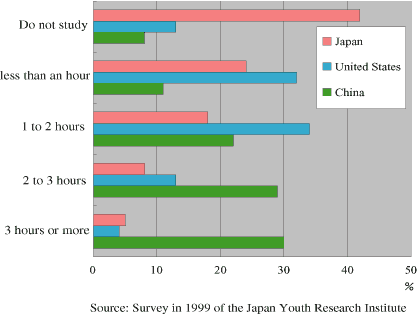 The policy to reduce educational contents has already been decided by the government and it is unlikely to change immediately. However, as the world becomes more globalized and information-oriented, the social requirement for education has expanded to its extent. The problem is whether school education can correspond to such expanding educational contents. School education nowadays face problems such as truancy, bullying, and classroom/school collapse, and is caught in a dilemma between an increasing number of children who turn their backs on school and an increasing amount of educational contents required by society. School education in such a circumstance is one of the grave concerns in Japan today. Decline in academic ability is nothing but a phenomenon caused by this situation.
The policy to reduce educational contents has already been decided by the government and it is unlikely to change immediately. However, as the world becomes more globalized and information-oriented, the social requirement for education has expanded to its extent. The problem is whether school education can correspond to such expanding educational contents. School education nowadays face problems such as truancy, bullying, and classroom/school collapse, and is caught in a dilemma between an increasing number of children who turn their backs on school and an increasing amount of educational contents required by society. School education in such a circumstance is one of the grave concerns in Japan today. Decline in academic ability is nothing but a phenomenon caused by this situation.However in December 1999, the Ministry of Education announced that academic ability of the eighth-graders (second year of junior high school) had not declined. According to the quick report of "International Survey on Education in Science and Mathematics" conducted every five years by the International Association for the Evaluation of Educational Achievement, it was reported that Japanese junior high school students ranked third in the world both in science and mathematics, showing that their academic ability did not decline since four years ago. (Japan ranked first, second and third, respectively, in the first, second and the third survey.) The final result released in December 2000 showed that Japan ranked fifth in mathematics and fourth in science (see Figure 4).
Figure 4 Scores of International Survey on Education in Science and Mathematics
(Surveyd in 1999. Numbers in parentheses are rankings of the previous survey of 1995. The negative sign (-) refers the country did not participate in the survey of 1995. Numbers are average scores)
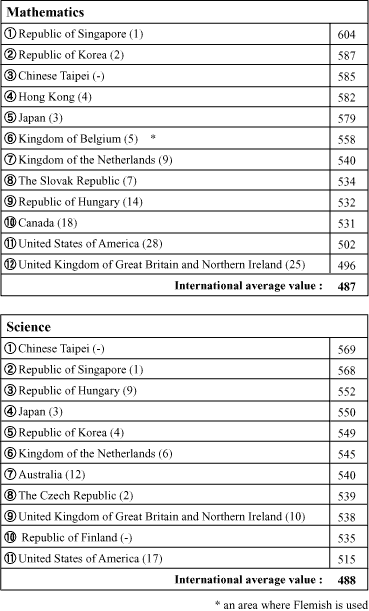 The problem was that the majority of the students did not like mathematics. The survey conducted by Professor Kazama at the International Christian University in Tokyo showed that Japan had the lowest percentages of students who thought that scientific knowledge is important for their everyday lives, and/or who want to work using their scientific knowledge (see Figure 5). For example, Singapore ranked first in science scores and a high percentage of students thought science is important and were interested in science-related work as shown in the correlation matrix. The United States ranked 17th in the test scores but compared with Japan, the percentages of students who thought science is important and were interested in science-related work was higher than that of Japanese students. Japanese students had high academic scores, but their correlational coefficient was the lowest. What does that mean?
The problem was that the majority of the students did not like mathematics. The survey conducted by Professor Kazama at the International Christian University in Tokyo showed that Japan had the lowest percentages of students who thought that scientific knowledge is important for their everyday lives, and/or who want to work using their scientific knowledge (see Figure 5). For example, Singapore ranked first in science scores and a high percentage of students thought science is important and were interested in science-related work as shown in the correlation matrix. The United States ranked 17th in the test scores but compared with Japan, the percentages of students who thought science is important and were interested in science-related work was higher than that of Japanese students. Japanese students had high academic scores, but their correlational coefficient was the lowest. What does that mean?Figure 5 Correlation between students who think scientific knowledge is important throughout life and those who want to pursue science-oriented career
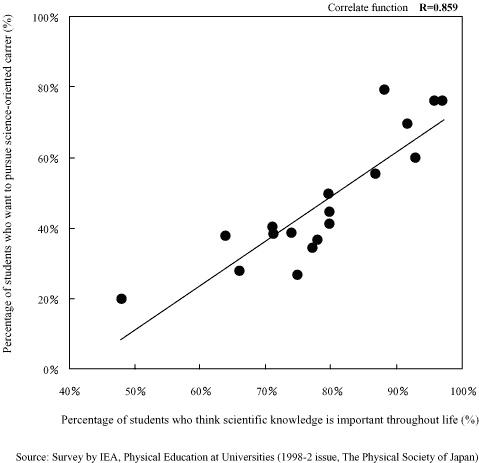
Explicit intelligence and implicit intelligence
I interpret the so-called academic ability as the ability one acquires in school education. However, what is really necessary for human beings is the intelligence and intellect to make use of academic ability one has learned at school. Let us compare two types of intelligence or intellect and how we acquire them (see Figure 6).
Figure 6 Gap between explicit and implicit intelligence
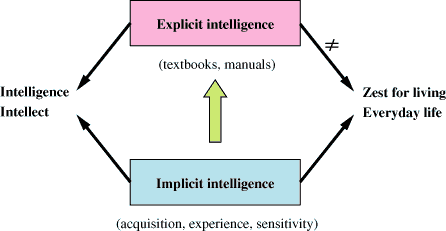 One is called explicit intelligence. The textbooks issued by the Ministry of Education are manualized, so therefore, all students can study in the same way and the contents can be interpreted in the same way. However, if one continues to learn that way, knowledge tends to become apart from real life. It seems that Japanese children have acquired high academic ability through such explicit intelligence, but lack fondness for the subject and awareness of how science is related to their lives. However, they may not have the willingness to learn something using that knowledge, either.
One is called explicit intelligence. The textbooks issued by the Ministry of Education are manualized, so therefore, all students can study in the same way and the contents can be interpreted in the same way. However, if one continues to learn that way, knowledge tends to become apart from real life. It seems that Japanese children have acquired high academic ability through such explicit intelligence, but lack fondness for the subject and awareness of how science is related to their lives. However, they may not have the willingness to learn something using that knowledge, either.The other type is called implicit intelligence, which is acquired through experience and sensitivity. This knowledge is very personal and difficult to teach. For instance, in order to learn how to swim, he or she will go to a swimming pool and have the experience of swimming. He or she does not learn how to swim from a book. Such kind of knowledge will remain for a very long time and is necessary for the child's development.
Comparing these two types of intelligence, explicit intelligence do not remain for a long time. If students were to take an entrance exam a few years after they have entered the school, most students may not be able to answer half of the questions. Students must have acquired only the superficial intelligence, thinking that all they had to do was to pass the entrance exam.
It is desirable that both implicit and explicit intelligence are integrated to form a well-balanced intelligence or intellect. Japanese children seem to learn too much of explicit intelligence. We need to educate children with a good balance between explicit and implicit intelligence.
Low self-evaluation of Japanese children
While it is important to acquire intelligence and intellect, it is more important for children to have an awareness to learn on one's own. However, the survey conducted by the Benesse Educational Research Center revealed that self-evaluation of Japanese children is very low (see Figure 7).
Figure 7 Self-evaluation of elementary school students
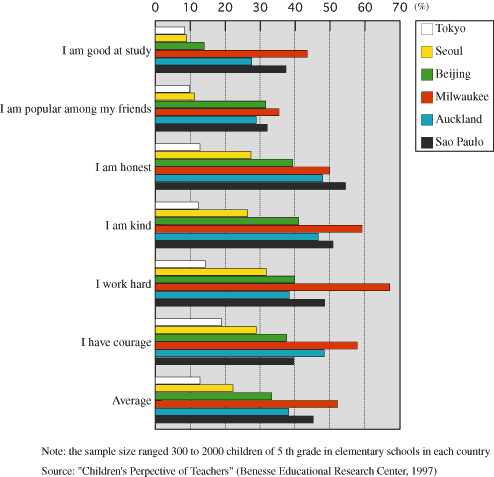 In the survey, fifth-graders of six different cities (i.e., Tokyo, Seoul, Beijing, Milwaukee, Auckland and Sao Paulo) were asked "Do you think you are good at studying?" and "Do you think that you are popular among your friends?". About 10% of Japanese children answered "yes" to these questions. It is unfortunate that most Japanese children think they are neither popular nor good at studying. On the other hand, children in other cities have higher sense of self-evaluation. Why is that? Is it possible to raise the children's self-evaluation, self-respect and self-acceptance by incorporating a different kind of education? This is another big educational issue in Japan.
In the survey, fifth-graders of six different cities (i.e., Tokyo, Seoul, Beijing, Milwaukee, Auckland and Sao Paulo) were asked "Do you think you are good at studying?" and "Do you think that you are popular among your friends?". About 10% of Japanese children answered "yes" to these questions. It is unfortunate that most Japanese children think they are neither popular nor good at studying. On the other hand, children in other cities have higher sense of self-evaluation. Why is that? Is it possible to raise the children's self-evaluation, self-respect and self-acceptance by incorporating a different kind of education? This is another big educational issue in Japan.
Japanese parents are not highly satisfied with their children
What do parents think of their children with low self-evaluation? According to the survey conducted by the Ministry of Education, parents in Japan have a very low satisfaction with their child's development (see Figure 8).
Figure 8 Parent's satisfaction with their children's development
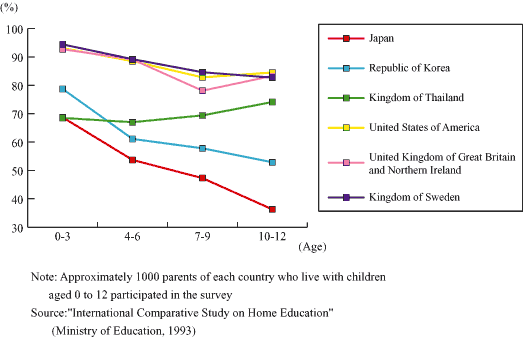 In the survey, parents in six countries (i.e., Sweden, the United Kingdom, the United States, Thailand, South Korea and Japan) were asked questions such as "Are you satisfied with your children's development?" In three countries including Sweden, 80 to 90% of the parents answered that they were satisfied with their child's development regardless of their age. In Japan, about 30% of the parents were not satisfied until the child reached the age of three. The degree of satisfaction decreases as their children grows up. About 60% of Japanese parents were not satisfied with their 12-year-old child's development. It is impossible for children to have a high sense of self-evaluation while their parents do not perceive their child's growth positively. However, this result does not mean that Japanese parents are not keen on child rearing; they are as enthusiastic as their counterparts in other countries. The difference seems to come from the way of child rearing.
In the survey, parents in six countries (i.e., Sweden, the United Kingdom, the United States, Thailand, South Korea and Japan) were asked questions such as "Are you satisfied with your children's development?" In three countries including Sweden, 80 to 90% of the parents answered that they were satisfied with their child's development regardless of their age. In Japan, about 30% of the parents were not satisfied until the child reached the age of three. The degree of satisfaction decreases as their children grows up. About 60% of Japanese parents were not satisfied with their 12-year-old child's development. It is impossible for children to have a high sense of self-evaluation while their parents do not perceive their child's growth positively. However, this result does not mean that Japanese parents are not keen on child rearing; they are as enthusiastic as their counterparts in other countries. The difference seems to come from the way of child rearing.I assume that Japanese parents want their children to be perfect. Since the birthrate is low, parents put too much expectation on one child to behave well and to be good at anything. When parents bring up children in such a way, they tend to think their children are no good if there is anything they cannot do. Children are sensitive enough to recognize the subtle change in their parents' facial expressions and behavior, so they work very hard to be good in front of their parents. Children should be allowed to act selfishly, say what they like to say and have fun when they are with their parents. Therefore, it must be stressful for them to be nervous in front of their parents. I assume that school is the place where children can diffuse their stress. This may be one of the reasons why classroom collapse can be seen even among the first-grade students at elementary schools.
When considering children's development there are two aspects we should look at. One is academic skill. We must ensure that their learning ability grows properly. The other is zest for living, which promotes acquisition of various behavioral skills, enhancement of self-evaluation, and self-esteem.
The American education policy and calls for zest for living in Japan
When Japan was working on its educational policies to enforce five-day school system in 1997, the U.S. President Bill Clinton mentioned the followings in his State of the Union address: "All the eight-year-olds should be able to read well. All the twelve-year-olds should be able to use the Internet. Doors to college should be open to all the eighteen-year-olds. All the adults in the United States should be able to continue their study all their life." In the United States, such specific proposal was made, and in the following year of 1998, a specific action was taken for the enhancement of educational standards. As seen in the previous International Survey on Mathematics and Science, it may have been due to such a policy that American students scored much higher in mathematics than in the past.
In Japan, on the other hand, the 15th Central Council for Education proposed enhancement of zest for living in its recommendation (see Figure 9). There is no doubt that such skill is necessary, but no specific plans were set out to enhance it.
Figure 9 Structure of zest for living
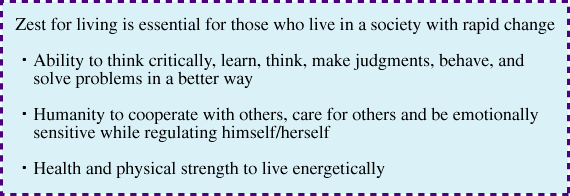 One of the big differences between Japan and the U.S. is how educational policies are proposed. The Curriculum Council was established in order to exemplify zest for living, and presented four objectives of the new curriculum which starts in the FY 2002 (see Figure 10).
One of the big differences between Japan and the U.S. is how educational policies are proposed. The Curriculum Council was established in order to exemplify zest for living, and presented four objectives of the new curriculum which starts in the FY 2002 (see Figure 10).Figure 10 Objectives of the new school curriculum
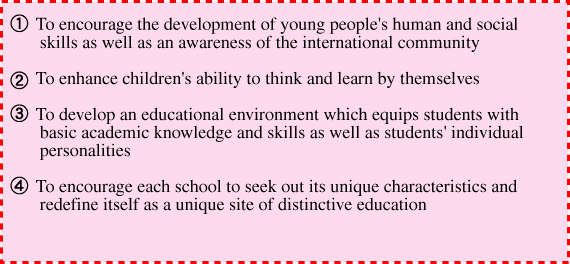 First phrases such as "humanity," "sociality," and "an international community," are the keywords of the new curriculum. And "the development of awareness" is very important. It is probably the first time that the term "awareness" is used in the objectives. Awareness is not something that can be taught, but the Council strongly calls for education that encourages every child to have his or her awareness.
First phrases such as "humanity," "sociality," and "an international community," are the keywords of the new curriculum. And "the development of awareness" is very important. It is probably the first time that the term "awareness" is used in the objectives. Awareness is not something that can be taught, but the Council strongly calls for education that encourages every child to have his or her awareness.Second, "The ability to think and learn by themselves" in the second objective is also to be acquired by every individual. The third objective is "to successfully equip students with basic knowledge and skills." In the past it emphasized the importance of basic knowledge and skills, which is however, a theory from the teachers' perspective. "To successfully equip," means that such knowledge and skills must be acquired by every individual. It is not the Ministry of Education and Science, but the teachers and schools, who should provide them with such educational framework.
Finally the fourth objective emphasizes that schools should consider the most appropriate education for their students and that teachers should generate a unique kind of education.
In other words, we are to consider what kind of education can be provided to each individual student. However, as Figure 1 indicates, school educational coverage in Japan is decreasing and is not capable of solving all the problems alone. It is necessary that schools should organize an educational system so that they can work together with local communities and other educational institutions.
Individualized education and changes in schools
The Ministry of Education and Science is taking some measures in order to realize individualized education. When the Ad Hoc Educational Council was held in 1985, Japan Teachers' Union proposed to have smaller number of students in each class (i.e., 35 students in a class). Reduction of the number of students per class had been often discussed since there were too many students in one classroom. Opposing Japan Teachers' Union's proposal of thirty-five students per classroom, the Council made another proposal, calling for a class made of less than thirty-five students. Unfortunately that did not happen and the number of students remained unchanged at forty students per class.
However, there came a new proposal to make smaller study groups, while keeping the number of students in a class forty. For instance, two classes composed of 40 students in each class can be divided into three study groups, comprising of twenty-six, twenty-seven and twenty-seven students in each group. In addition to class teacher, another teacher is assigned to be responsible for teaching so that classes can be taught in smaller size. In some cases, the plan has already made progress. In other words, the school educational system can be individualized. Some people suggest that students should be assigned to study in groups based on academic proficiency to enhance individualized education. Study groups can be formed with different levels of proficiency such as advanced, intermediate and moderate.
At present, there is only one session of art class per week. Students cannot work much in one session, but quite a lot can be done if they had four sessions in one day. If such an arrangement can be done, art classes will be unnecessary in the other weeks. Then, teachers can visit different schools every week, and circulation of teachers becomes possible.
An other suggestion is to hire four unexperienced teachers, when an experienced, highly-paid teacher retires. In order to avoid misunderstanding, I'd like to note that certain number of experienced teachers are necessary to run the core of the school organization. Teachers other than these core members or part-time teachers can be those who visit various schools. Having teachers who work in diverse ways is likely to change school education substantially.
Meanwhile, the number of hours for teaching is limited. New countermeasures are called for, although I am afraid it is very difficult to take new measures. I assume that it becomes all the more necessary for educational institutions other than school to support school education. Otherwise, it is impossible for education to catch up with the rapid development of global and information-oriented society.
Integrated study
There were three educational elements in school education prior to integrated studies: academic skills, moral education, and special activities. Integrated study was introduced as a turning point of Japanese educational system, which does not limit its scope to these elements, but encourages studies in a broader sense such as global understanding and environmental issues.
It is regrettable that current school education has prevented children from getting in touch with society that are necessary for children. Integrated study aims to overcome this issue.
Since Japanese education has put priority on academic skills, schoolteachers have taught students in an isolated situation. On the other hand, there are people outside school who have various competencies that teachers do not have, and with their support we can expand the children's scope of study and expose children to various challenges that cannot be found in textbooks. I believe integrated study can make a breakthrough in school education to lighten its burden.
Another direction integrated study can guide to is changes in children's characteristics through such learning practices. Problems were pointed out that children nowadays simply wait for instructions, cannot make their own decisions, lack a challenging spirit, are not sociable, and have a slow self-development. Since integrated study encourages students to make their own decisions, it will nurture the ability of self-determination and identification of problems. It will also nurture a challenging spirit toward what children want to pursue. Children will be able to acquire sociability and social behaviors through various encounters with adults in the community.
Children are highly satisfied with integrated study
According to a survey conducted by the Benesse Educational Research Center in 1999, children were generally satisfied with integrated studies. More than 80% of the students showed high satisfaction, saying that they liked selecting topics according to their interest and deepening their ideas or thoughts. This result implies that school education in the past was not forming their awareness or study attitudes to actively learn.
Hours spent for the integrated study, accounts for only 10% of the total number of classes. I believe that 10% is enough. The remaining 80% are academic studies and it is unthinkable to cut more learning contents and increase time for integrated study. Academic learning plays an important role to provide basic knowledge and skill, which creates the basis of integrated study.
Evaluation of integrated study
The Curriculum Council has announced an evaluation standard for integrated studies. The standard described in the cumulative guidance record is very important. I paid attention on evaluation aspects because they clarify what integrated study is expected to result.
Basically there are five evaluation aspects: to enhance 1) ability for problem identification, 2) problem-solving capability, 3) learning and thinking skills, 4) active and creative study attitude, and 5) consideration toward one's way of life. These aspects should be dealt in the whole framework of education, but it is particularly important to nurture children's such competency as a unique objective of the integrated study.
Structure of academic skills in integrated study
Most of the evaluation aspects of integrated study can be converted into the so-called academic skills (see Figure 11). These academic skills are acquired while achieving global understanding and information. For students, acquiring global understanding and information are not the same. It is true that learning global understanding is important, but what is more important is to learn how to overcome these challenges, for example, through such learning experience, rather than how to pick up those concepts.
Figure 11 Structure of academic skills in integrated studies
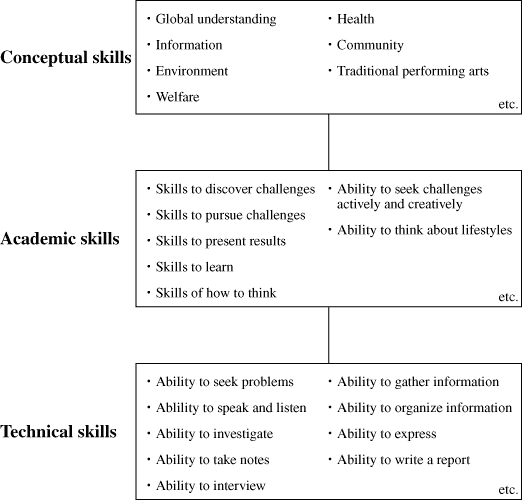 What is important here is that academic skills such as pursuing challenges are not something that can be acquired solely in integrated studies. When children visit a welfare center to interview elderly people and nursing staffs, they would wonder how to make a good interview, and how to organize what they have learned from the interview. As can be seen, skills to pursue challenges require various abilities such as speaking, listening; children also need ability to take notes while making an interview and to make a presentation in front of the class. In fact academic skills shown in Figure 11 are composed by these technical skills. And these skills are acquired in Japanese language classes.
What is important here is that academic skills such as pursuing challenges are not something that can be acquired solely in integrated studies. When children visit a welfare center to interview elderly people and nursing staffs, they would wonder how to make a good interview, and how to organize what they have learned from the interview. As can be seen, skills to pursue challenges require various abilities such as speaking, listening; children also need ability to take notes while making an interview and to make a presentation in front of the class. In fact academic skills shown in Figure 11 are composed by these technical skills. And these skills are acquired in Japanese language classes.As for the relationship between Japanese language classes and integrated studies, there were children who could not take notes even though their teachers told them to do so. This was because they had not acquired skills to take notes although they learned that taking notes is important at school. Japanese education has seemingly taught children such skills. However, if children were not taught to make use of these skills freely, it is impossible for them to apply such skills to various situations. One of the challenges education is facing now is how to help children acquire those skills.
Skills are something that can be learned in various manners considering the surrounding situations. Finally there comes an opportunity for children in Japan to apply their knowledge and understanding to a given situation and develop skills.
On the other hand, teachers are not fully aware of these situations. Teachers still tend to distinguish between integrated study and academic study; that is, the former is only for activities while the latter is only for understanding. There will soon be a gap among schools due to a difference of teachers' awareness, which will cause a big problem.
To summarize, 10% of the total school hours is enough for integrated study, but this is an opportunity to learn how to acquire such skills. Balance between integrated study and academic study is also important.
Study values the present and future
Students are confused, trying to find out how they can make use of their skills they have acquired in their learning experience. For example, there are students who have entered the Economics department without learning mathematics, and students who have entered the medical department without learning biology because these subjects were not required in their entrance exam. The problem is that academic skills for entrance exams do not match the skills that are required for what they want to pursue in college. What is important is the latter. It is necessary for adults to help children think what kind of skills are required in their future.
Not only children but also parents are having great difficulties in holding clear study values. We prepared several pairs of two extreme questions and asked principals at junior high school and mothers of infants to indicate which was more important; for instance, acquisition of zest for living vs. success in society, enhancement of individual personalities vs. entering famous universities and first-class companies, importance of sociability and human nature vs. importance of individuality, or coexistence vs. competition.
The principals at secondary school selected the former alternatives such as acquisition of skill for living, while the mothers of infants opted for the latter choice such as success in society. It can be seen not only that study values of teachers are different from those of mothers, but also that study values of people including children are getting more diversified.
It is very important to consider what kind of educational advice and education itself can be offered that matches each lifestyle of children. Education should no longer be stereotyped and conventional to everyone. We must think how we can offer various types of education to meet individual needs of children.














